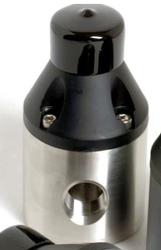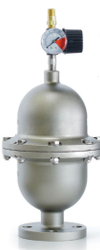Positive displacement chemical metering pump designs are the best available for injecting chemicals into processes where such dosing is needed. There are many additional components that can enhance the performance of your chemical dosing application. This article will walk through the more popular components found in chemical metering applications and mention the purpose each of them serve.
Chemical injection accessories
 |
| Griffco Calibration Column |
Calibration columns: even for companies like ours, Madden Pump, who bench test and calibrate every pump before shipping, calibration columns are important. If your application’s operating pressure ever changes, or if you have multiple applications, a calibration column is going to save you a head ache. These units allow you to quickly and easily measure and calibrate your chemical injection pump’s output based upon the current pressure it is operating against.
Y strainers: positive displacement type chemical dosing pumps are the best at chemical dosing for this main reason, they accurately and repeatedly dose a finite amount of liquid. This usually means the valve assembly is compact and operates on a check ball (or similar) system, to ensure accurate dosing. Debris reaching the inside of your metering pump’s solution head can cause inaccurate output as well as early fatigue of parts.
 |
| Griffco Back Pressure & Relief Valve |
Pressure relief valves: no system is perfect, and no application is immune to problems. A pressure relief valve ensures your chemical injection pump’s safety from any issues that may arise from piping, other components or the process itself downstream. The relief valve can be adjusted to divert flow back to the source, or pump’s suction line within a range of pressures (usually 10-150 PSI for chemical metering applications).
Back pressure valves: the term positive displacement refers to the action of moving fluid by trapping a fixed amount of it, and then forcing that trapped amount onto the next section (in our case piping). As mentioned earlier the trapping motion is usually accomplished using check ball valves on the suction end and discharge end of the pump’s valve assembly. If the process does not have any back pressure, you risk inaccuracy in your chemical injection pump’s output. This would be due to the balls not seating firmly and consistently with each stroke of your dosing pump. A back pressure valve uses a spring and diaphragm to apply positive discharge pressure to the chemical metering pump system.
Pulsation dampeners: positive displacement chemical metering pumps normally use either a piston and/or a diaphragm as the driving force to inject the chemical. This results in a pulsing flow rate. Pulsating flow rates are normally fine for chemical injection applications, but in cases a
 |
| Blacoh/Sentry Pulsation Dampener |
smooth flow rate is needed, or just for added equipment protection, using a pulsation dampener is a cost effective way to produce smooth, steady flow with a positive displacement type chemical metering pump. Pulsation dampeners eliminate 95% of pressure spike.
Pressure gauge: without a pressure gauge setting your back pressure valve and relief valve will very difficult. Madden Pump recommends using liquid filled pressure gauges with positive displacement chemical dosing pumps as they minimize vibration and help display accurate readings.
Foot valves: it isn’t always possible to provide a metering pump with a flooded suction set up. In cases where the pump needs to overcome a suction lift, foot valves are a great solution. Foot valves keep liquid in the suction line so that after it is primed the first time, in theory, you will never have to prime the suction line again.
Non-essential, but useful chemical injection accessories
Leak detecting pressure switch: in Madden Pump’s Type DDB Double Diaphragm design, for example, there is a spacer between the primary and secondary diaphragm where a pressure switch can be installed. The space between the diaphragms will have no pressure when operating successfully. If the primary diaphragm were to fatigue, the process’ operating pressure would now be residing in between the two diaphragms which would then trip the leak detecting pressure switch. Madden recommends wiring this to sound/signal an alarm as well as to shut off the pump.
Flow indicator: flow indicators are a simple on/off type of component. These accessories are set to your chemical metering pump’s flow range to send an “it is on/off” signal. As long as the pump is pumping, your system will show a “good” sign, if it stops pumping, the flow indicator will let you know something is wrong with the system.
Variable frequency drives: VFD’s allow you to control motor speed locally or remotely to adjust your pumps output. These can also be used in conjunction with a Programmable Logic Controller for further automation. Most chemical injection pumps’ design include a manual stroke length adjustment for output control. A VFD increases flexibility with your chemical dosing application.
Conclusion
Most of the time, accuracy and consistency in a chemical metering application is of the utmost importance. Hence the reason for the metering pump design. So, if you have a standard chemical metering application which needs a chemical dosing pump and associated accessories, make sure to put in time to consider all the benefits and features of metering pump accessories, not just the pump.
Madden Pump and our reps/distributors have many years of experience with chemical injection applications. We would love to assist you designing and providing the needed equipment for your next metering application.
